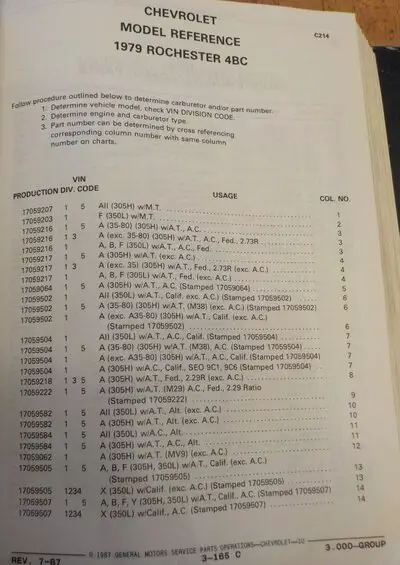fantastic info. thanks for sharingIt‘s the „Q-jet tuning paper“ by Lars Grimsrud
Qjet for 2.29 axle? Why?
- Thread starter malibu79
- Start date
- Status
- Not open for further replies.
from what I have read there was 2 diffeent 305's is 79, one was higher hp than the other and there was no 2.29 rear offered as an option. There must be something different with the model with the 2.29 rear end
I believe the difference is in the calibration of the carb itself, probably different jets and rods. A vehicle with 2.29 gears will spend its time operating in a different rpm range than a car with 3.08s. I know when I swapped out the 2.73s for 3.73s in my 1979 Hurst, I had to have my carb and ignition timing adjusted to optimize the change.
Here's a picture of the 1979 quadrajet list taken out of the 1976-81 Chevy parts and illustration catalog. Several of the carbs are model and rear end specific.

Here's a picture of the 1979 quadrajet list taken out of the 1976-81 Chevy parts and illustration catalog. Several of the carbs are model and rear end specific.

That sounds legit to me. But this also means that an actually „incorrect“ equipped carb for your application can be adjusted by simply changing the rods, jets and power piston spring (as always) OR any Qjet primary section can be tuned this way for more low end performance🤔 If it works for a 2.29 axle,the calibration set up probably works even better with a 2.41ect.? At the end it‘s about the rpm range i think, how red78calais4speed just wrote...
In my! case the Prim. Jet Area is a bit too small (2.53 vs. 2.70) and the WOT Pri. Jet Area is way too big (3.42 vs 4.10!) The power piston spring is also different. Sec. Rods identical...I hope my mpg will improve a bit😄
I keep you updated with my experiences after the swap right here👍🏻
In my! case the Prim. Jet Area is a bit too small (2.53 vs. 2.70) and the WOT Pri. Jet Area is way too big (3.42 vs 4.10!) The power piston spring is also different. Sec. Rods identical...I hope my mpg will improve a bit😄
I keep you updated with my experiences after the swap right here👍🏻
Last edited:
Look up the carbs here. http://www.newagemetal.com/pages/Chevrolet/index.html Compare innards.
Don't trouble yourself trying to apply too much logic.
Back then, the MFR's were doing weird things to satisfy both the emission and fuel mileage regs of the day. GM would change from a 2BBL to 4BBL on some engines as standard equipment, just to gain a fraction of a MPG in the mileage tests. Oldsmobile 260's and Pontiac 301's used a Dualjet carb, while Chevy motors had a conventional Rochester 2 BBL in 1978, just because of Rochester's production capacity.
I did a considerable amount of Q-Jet tuning during the non-computer years and one possible guess is that Chevy needed to very slightly richen the fuel mixture with the 2.29 axle to avoid a possible tip-in of the secondaries during the EPA mileage test. Since the optional gear ratios were tested for emissions, but not mileage, it wasn't necessary to change those.
Bill
Back then, the MFR's were doing weird things to satisfy both the emission and fuel mileage regs of the day. GM would change from a 2BBL to 4BBL on some engines as standard equipment, just to gain a fraction of a MPG in the mileage tests. Oldsmobile 260's and Pontiac 301's used a Dualjet carb, while Chevy motors had a conventional Rochester 2 BBL in 1978, just because of Rochester's production capacity.
I did a considerable amount of Q-Jet tuning during the non-computer years and one possible guess is that Chevy needed to very slightly richen the fuel mixture with the 2.29 axle to avoid a possible tip-in of the secondaries during the EPA mileage test. Since the optional gear ratios were tested for emissions, but not mileage, it wasn't necessary to change those.
Bill
Sorry for late reply, busy times...the new Q is reassabled, ultrasonic cleaned and rebuilded. Since i got the carb disassembled i have to make a bench set up. Unfortunately the APT screw was out too...
Have anyone out there a set up for me? Or have a unmolested 17059222 on shelf and can count the turns in till seated or so for the APT and idle mixture screws? I tapered the plugged bore above the APT and put a set screw in to make adjustments easy on road...
ANY help is really appreciated! I don‘t want to burn my exhaust valves or damage my engine...Thanks!
Have anyone out there a set up for me? Or have a unmolested 17059222 on shelf and can count the turns in till seated or so for the APT and idle mixture screws? I tapered the plugged bore above the APT and put a set screw in to make adjustments easy on road...
ANY help is really appreciated! I don‘t want to burn my exhaust valves or damage my engine...Thanks!
- Status
- Not open for further replies.
Similar threads
- Replies
- 1
- Views
- 219
- Replies
- 5
- Views
- 291
- Replies
- 29
- Views
- 1K
GBodyForum is a participant in the Amazon Services LLC Associates Program, an affiliate advertising program designed to provide a means for sites to earn advertising fees by advertising and linking to amazon.com. Amazon, the Amazon logo, AmazonSupply, and the AmazonSupply logo are trademarks of Amazon.com, Inc. or its affiliates.



